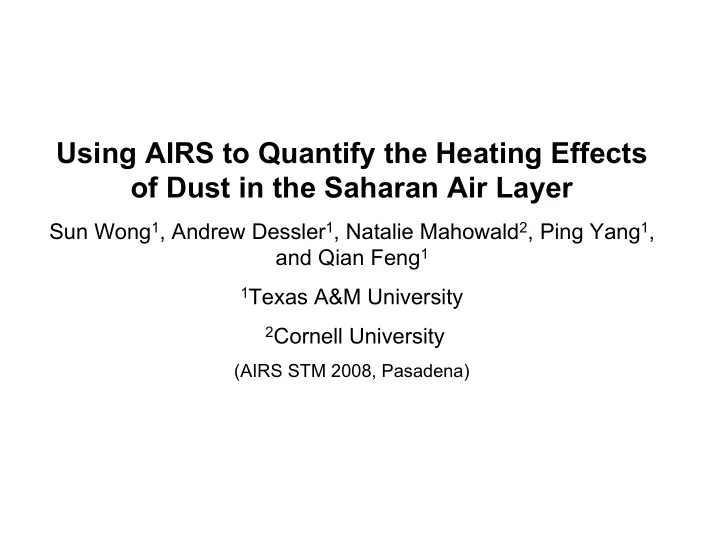

Using AIRS to Quantify the Heating Effects of Dust in the Saharan Air Layer Sun Wong 1 , Andrew Dessler 1 , Natalie Mahowald 2 , Ping Yang 1 , and Qian Feng 1 1 Texas A&M University 2 Cornell University (AIRS STM 2008, Pasadena)
Aqua MODIS Aerosol Optical Thickness (AOT) ?
• How important is the Saharan dust in the radiative heating budget in the SAL? • How important is the dry anomaly in the radiative heating budget in the SAL? • Can the heating from dust maintain the warmness of the SAL?
Aqua MODIS Aerosol Optical Thickness (AOT) ?
AIRS Saharan Air Layer (SAL)
AIRS Saharan Air Layer (SAL) Dunion and Velden, BAMS 2004; Wong and Dessler, GRL, 2005
AUG-SEP 1-2.5 µm 0.1-1 µm 2.5-5 µm 5-10 µm Mahowald et al., JGR 2003
AIRS T (0-0.3 AOT) H( background) GSFC CLIRAD AIRS q (0-0.3 AOT) Flx(background) (chou et al., 2003) Dust (0-0.3 AOT)
AIRS T (0-0.3 AOT) H( background) GSFC CLIRAD AIRS q (0-0.3 AOT) Flx(background) Dust (0-0.3 AOT) AIRS T (0-0.3 AOT) H(Dust) GSFC CLIRAD AIRS q (0-0.3 AOT) Flx(Dust) Dust (AOT > 0.8)
AIRS T (0-0.3 AOT) H( background) AIRS q (0-0.3 AOT) GSFC CLIRAD Flx(background) Dust (0-0.3 AOT) AIRS T (0-0.3 AOT) H(Dust) AIRS q (0-0.3 AOT) GSFC CLIRAD Flx(Dust) Dust (AOT> 0.8) AIRS T (0-0.3 AOT) H(SAL) AIRS q (AOT > 0.8) GSFC CLIRAD Flx(SAL) Dust (AOT > 0.8)
SAL
SAL
SAL
SAL
Aqua MODIS Aerosol Optical Thickness (AOT) ?
Heating Against Thermal Cooling at 850 hPa AOT >0.8 0.6-0.8 0.5-0.6 0.4-0.5 0.3-0.4 20-30W 0.21 0.06 0.04 0.06 0.06 30-40W 0.30 0.11 0.08 0.03 0.04 40-60W 0.15 0.01 –0.04 –0.04 –0.03
Conclusions : • Dust radiative heating ~ 50% of the SAL Heating • SAL (dust + low H 2 O) heating ~ T anomaly profiles • (dust + low H 2 O) maintains the T anomaly in the SAL. West of 50°W, SAL of AOT < 0.5 may lose the ability to maintain the T anomaly against thermal relaxation
• Radiative (dust + dryness): GSFC CLIRAD (Chou et al., 2003) • Dynamical: NCEP v � T - Horizontal advection: � � T T � �� - Vertical advection + adiabatic: � � + p p � • Latent Heat ???
SW LW – + – + DUST H 2 O – + –
Recommend
More recommend